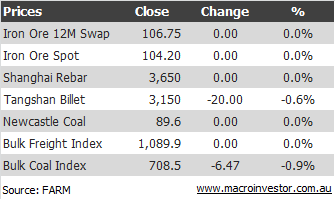
Find yesterday’s steel complex prices above.
There are a couple of interesting bits around on the iron ore price today. The first is from Alphaville on ye auld price floor:
The cost curve theory is that the highest cost producers (who happen to also be in China) will drop out when iron ore prices fall below $120, because they can’t make any margin on it. It is thought that this pull back in production will overshoot and then push the price back towards $120. And yes, it does kind of assume that demand is steady and growing — which does not seem to be the case now, according to the steel mills.
In guessing/understanding what this might mean for iron ore prices, the question is, who’s cutting — or will cut — their production the most: Chinese iron ore miners or Chinese steel mills? And will the iron ore miners overshoot?
If the Chinese iron ore mines do overshoot and cut too much, then the iron ore cost curve would appear and put a floor under iron ore prices. And who knows, perhaps it already has happened. Although the floor does not seem to be terribly stable just now, with iron ore dropping back to below $105 per tonne — much less than the fabled $120-125.
However, if demand has fallen for the longer term, then the floor would seem lower than many thought it would be.
Exactly. But to be honest, let’s drop the “price floor” drivel, eh? As I’ve said before, there is no difference whatsoever between the dynamics at play in the iron ore market than any other market, for any other widget, anywhere. I don’t hear anyone discussing coal, zinc, computers or chocolate in terms of a “price floor”. There’s just “the price” and it will go where the cheapest marginal tonne of supply says it should. As it always has. The “price floor” notion is the invention of a nation that has over-leveraged itself to a single commodity and can’t face the fact.
But where is the cheapest marginal source of supply? On that, there’s an interesting comment today from the AFR about Rio’s Simandou project:
It offers a much higher grade of ore than the Pilbara, the local labour is cheap and there’s the possibility of Chinese construction help.
But on nearly every other indicator, Simandou does not stack up well against the Pilbara.
The terrain is mountainous and the roads so poor that Rio has had to helicopter in drill rigs at great cost. Diesel power is also a necessity given the lack of grid power. There is a wet season from April to November which can bring extreme rain. The distance from the coast means longer rail distances that require blasting of mountains and the relocation of many villages…The shipping costs to Asia will be higher and therefore erode the quality premium if closer markets can’t be found.
…Rio now touts it has offloaded half of its risk to Chinese partner Chinalco.
No doubt all true. And the fall in the iron ore price will slow private African investment too. But not at Simandou, nor, if I’m any judge, any other mine in Africa with Chinese involvement, especially metals processing Chinese involvement that has a vested interest in getting supply up and fast. There is also the simple fact that the huge investment in West Africa tends to solve many of the sovereign risk factors cited in the article.
Here again is the chart I posted yesterday from the Hurst study at ANU:

That’s a pretty competitive cost base for West African iron ore. And it is coming on stream henceforth even as growth in the steel market stalls. We’re entering a contest for market share now and that means one thing: discounts!

